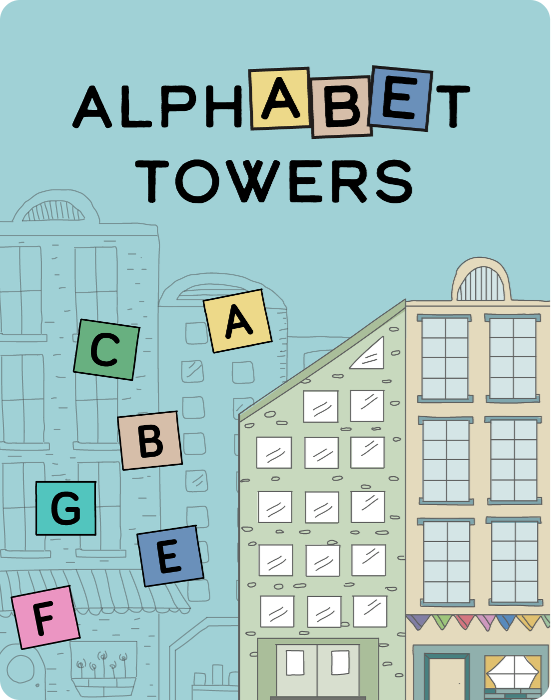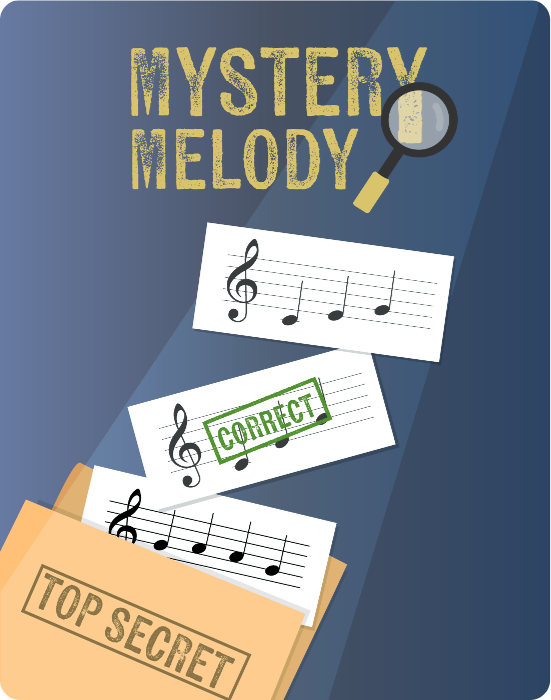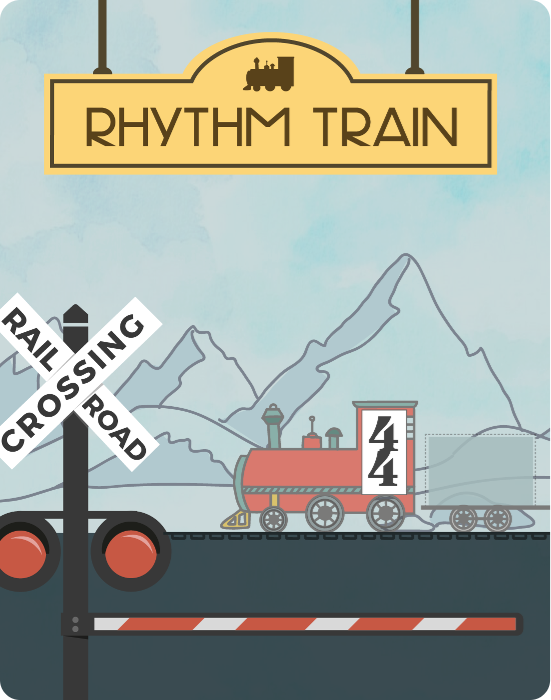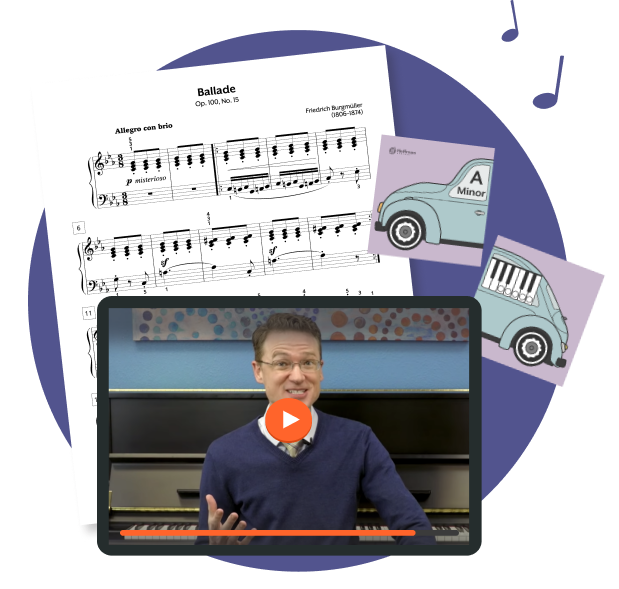THE HOFFMAN METHOD
A Whole-Music Approach to Teaching Piano
In a spirit of exploration and fun, the Hoffman Method immerses students in the language of music through a carefully designed sequence, always bridging from the familiar to the unfamiliar, and always connecting sound to symbol. The result is confident music makers who feel a profound sense of ownership and musical understanding. Students of the Hoffman Method can play by ear and by sight. They compose, improvise, sight read, and become truly fluent in the language of music.
A science-backed method for teaching piano to kids
Training both Ear and Eye
How does the Hoffman Method successfully teach students to play both by ear and by sight? The answer is grounded in the science of emergent literacy. Children are natural imitators, and their brains are wired to pick up language intuitively.
Step one is guiding a child to experience the music. We do this through listening, singing, solfège, and movement. Once the music feels familiar to the child, the next step is to explore the melodic and rhythmic patterns embedded in the music, which naturally leads to playing on the piano. Once the child has successfully sung and played a song, then they are prepared to explore the notational symbols.
These steps follow the same sequence that every child experiences in learning their native language: hear, imitate, then read.
Learn how to teach the Hoffman Method in your studio. Teacher training and resources are included with Teacher Studio!

Online games to teach piano skills
Kids love our games! Learning to read music fluently requires extensive repetition and practice. Our library of interactive online games makes it a delight for your students to get all the practice they need to level up in essential music theory skills, from staff reading to ear training.





All Premium games are included with Teacher Studio!

Resources for teaching the piano
300+ Video Lessons, Printable Sheet Music, and Teaching Resources
Expand your teaching toolkit with access to our extensive library of video tutorials, sheet music, music theory worksheets, flashcards, and our popular holiday-themed theory packets. With a Teacher Studio account, you receive access to ALL Premium content in the Hoffman Academy Store, along with a license for sharing it with your students. That’s a value of over $2,600 in sheet music and printable learning resources, all at no additional cost to you or your students.
The Hoffman Academy store features a rich selection of repertoire and learning resources, along with powerful search tools, making it easy to find the perfect piece, game, or theory worksheet for each student. Reinforce your in-person teaching with flashcard games, board games, printable finger puppets and more!
All of these teaching aids can be shared online with your students to help them practice at home between lessons. Manage all of your students, make assignments, and track their progress in one, easy-to-use account!
Keep the learning going at home with Teacher Studio
Say goodbye to students practicing incorrectly all week long. With Teacher Studio, you can assign students tasks to review and reinforce the music concepts they learned with you all week long. Your students can also advance their music theory skills at home using our online games, saving you precious time in your lessons to focus on the things you love to teach the most.
With Teacher Studio you can:
- Invite students to enjoy full Premium access to video lessons, practice sessions, and games!
- Assign customized tasks to each student and get notified when tasks are completed.
- Access teacher training videos, articles, and printable resources to support your piano teaching.

How to teach piano to beginners
Fluency from the Start
The Hoffman Method teaching principles are based in current learning science and over two decades of piano teaching experience, along with the experience of dozens of other teachers who have helped test and refine the curriculum. These principles, when applied together, lead to students who joyfully make music at the piano with a profound sense of ownership and independence.
Music Dictation
The science of emergent literacy teaches us that kids benefit greatly from writing activities as they learn to read. See a symbol once, and you may forget it a moment later. Write it down, and you’re much more likely to remember it. Additionally, melodic and rhythmic dictation practice helps your students to build the crucial mental connection between sound and symbol.
Improvisation & Composition
With the Hoffman Method, your students will enjoy improvising from the beginning, using our professionally-produced backing tracks. Students who improvise and compose grow to feel they are not mere music imitators, but music creators.
Transposition
Students of the Hoffman Method transpose their repertoire into each new key that they learn. Transposition is a skill that is often overlooked, but your students can master it readily if you introduce it early. Transposition strengthens your students’ ability to play by ear, aids in memorization, and helps them to better comprehend the tonal patterns in their music.
Efficient and Relaxed Technique
The Hoffman Method promotes a healthy technique from the first lesson, with a focus on arm weight and motions that are relaxed, flexible, and efficient. Establishing good habits from the start helps ensure your students are always ready to play their best!
Challenging and Inspiring
Every child is capable of excellence. The Hoffman Method supports teachers in leading students toward true musical fluency in a spirit of play and discovery. Hoffman Method pianists possess a remarkable sense of ownership and independence. They come to view themselves as real musicians who create music with confidence and joy.
Student Success
Kids love learning piano with the Hoffman Method. Students are engaged, so retention is high. Because they are motivated, students of the Hoffman Method make steady, impressive progress toward musical artistry–and parents are thrilled because their kids actually want to practice!
Teacher training and resources are included for free with Teacher Studio!

Frequently Asked Questions
-
How do I start teaching piano?
To get started as a piano teacher, first choose a method that you feel aligns with your own teaching goals and philosophy. There are many piano teaching methods to choose from, and it can be helpful to talk with other experienced piano teachers to find out which methods they like best. Once you have chosen a method, buy a copy for yourself and take some time to review it, so you feel familiar with the sequence of how and when new concepts are introduced. If you’d like to learn more about how to teach piano to kids using the Hoffman Method, check out our Teacher Training series.
Next, be sure you prepare your own teaching studio with all the materials, teaching aids, games, and resources you want to use. Check out our article What Every Piano Teacher Needs in Their Studio for ideas. Then, you’re ready to start spreading the word that you are open for business! Having a simple website can be a great way to find new piano students. Plus, don’t forget the power of networking. Join your local professional music teachers’ association, like your state chapter of MTNA, and let other piano teachers in your area know that you are accepting new students.
-
What do piano teachers teach first?
In a first piano lesson, it’s common for a piano teacher to start with teaching about the layout of the piano keys. The piano teacher will explain how the higher notes are on the right, and lower notes are on the left. They also will explore the pattern of alternating 2 and 3 black keys on the piano. In the first lesson, the teacher will also usually teach the student how to play a simple, short song. At Hoffman Academy, we like to get students started with Hot Cross Buns as their first song because it’s quick and easy to find the right notes to play on any group of 3 black keys.
Other music concepts that often are taught in a first piano lesson include the musical alphabet, the names of at least some of the white keys on the piano (C, D, and E are a common place to start), and some tips on how to sit at the piano and play with your best posture, including proper hand and finger shape.
-
What are the techniques for teaching piano?
One of the most powerful and simple techniques for teaching piano is teaching through imitation. The human brain is wired to learn very efficiently through simple observation and imitation. If you want your student to play a phrase with a beautiful crescendo, first let them hear and watch YOU play the phrase with a beautiful crescendo, then ask them to copy you.
Another technique for teaching piano, backed by learning science, is following the principle of “sound before symbol.” This means that a piano teacher should introduce the sound or auditory experience first, before teaching the written symbol. For example, a piano teacher might try clapping their hands to a quarter-note beat, then march around the room to a quarter-note beat, or sing a song with quarter notes. Once the student has heard and experienced quarter notes, then the teacher can introduce the symbol for quarter notes. When taught this way, students are more likely to remember the symbol because the brain has accumulated previous experience with the concept and can link the symbol to a concrete memory and sensory experience. To learn more piano teaching methods and techniques grounded in learning science, check out our Hoffman Method Teacher Training series.
-
How do you make beginner piano lessons fun?
Beginner piano students love learning by doing and experiencing rather than by listening to a long verbal explanation. To make beginner piano lessons fun, avoid long-winded explanations, and be sure to spend lots of time engaged in real music making together. You can sing together, drum or clap rhythms together, and play duets together. Another easy way to make it fun when you teach piano is by incorporating lots of stories and games into lessons. For example, when you teach how to find C, D, and E on the piano, you can use a fun story like Hoffman Academy’s Piano Street story. For game ideas check out our flashcards in the Hoffman Academy store, which come with ideas for games included. You can also check out our blog articles on Piano Games
-
What are tips for teaching piano to young children?
When you teach piano to young children, ages 5-7 or younger, it’s important to remember that most kids this age do not learn very effectively from a book. Young children will learn much better through active learning and direct experience, such as singing, chanting rhythms, playing music theory games, and learning simple, short songs by ear. The Hoffman Method is designed to work well with young children because it emphasizes this kind of learning by experience. With young children, it’s also very helpful to change activities frequently, to keep attention fresh. Finally, be sure to incorporate lots of stories and games into the learning.
-
What are common mistakes made while teaching piano?
A very common mistake by piano teachers while teaching piano is talking too much and over-explaining. They say “a picture is worth a thousand words,” and in teaching this means that you can usually get your message across much faster and efficiently by simply showing or doing rather than explaining. A good piano teacher will practice giving instructions or explanations in the fewest words possible, or even with no words at all! Instead of explaining a “crescendo” in words, simply demonstrate a crescendo.
Another common mistake in teaching piano is not spending enough time reviewing basics. Just because you teach something one week, doesn’t mean the student will remember it the next week. Basics must be constantly reinforced or the memory will fade, and progress will slow down as things start to feel confusing for the student. At Hoffman Academy, we help address this problem with our library of online learning games. When students play these games at home, it reinforces their music theory knowledge and skill so that in lessons they’re ready for more learning, saving you time in lessons having to re-teach old concepts.
-
What makes a good piano teacher?
A good piano teacher must possess a solid understanding of how students learn, be able to demonstrate excellent musicianship, have a strong understanding of music theory, and be able to inspire and motivate their students. A good piano teacher loves working with and mentoring young musicians, and constantly seeks to keep learning themselves and honing their teaching craft through professional development opportunities.
If you are interested in learning more about teaching piano using the Hoffman Method, check out our Hoffman Method Teacher Training Series.